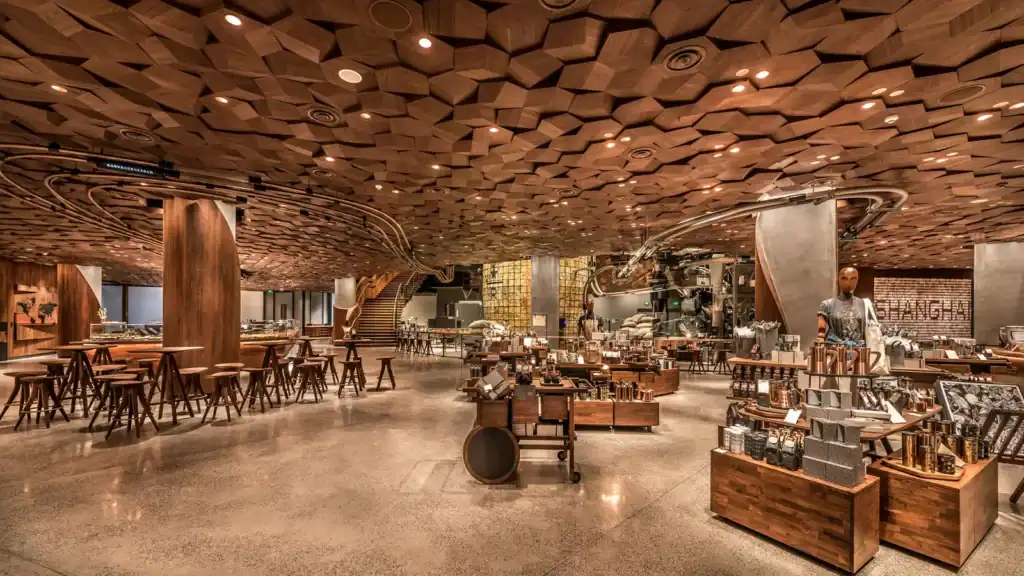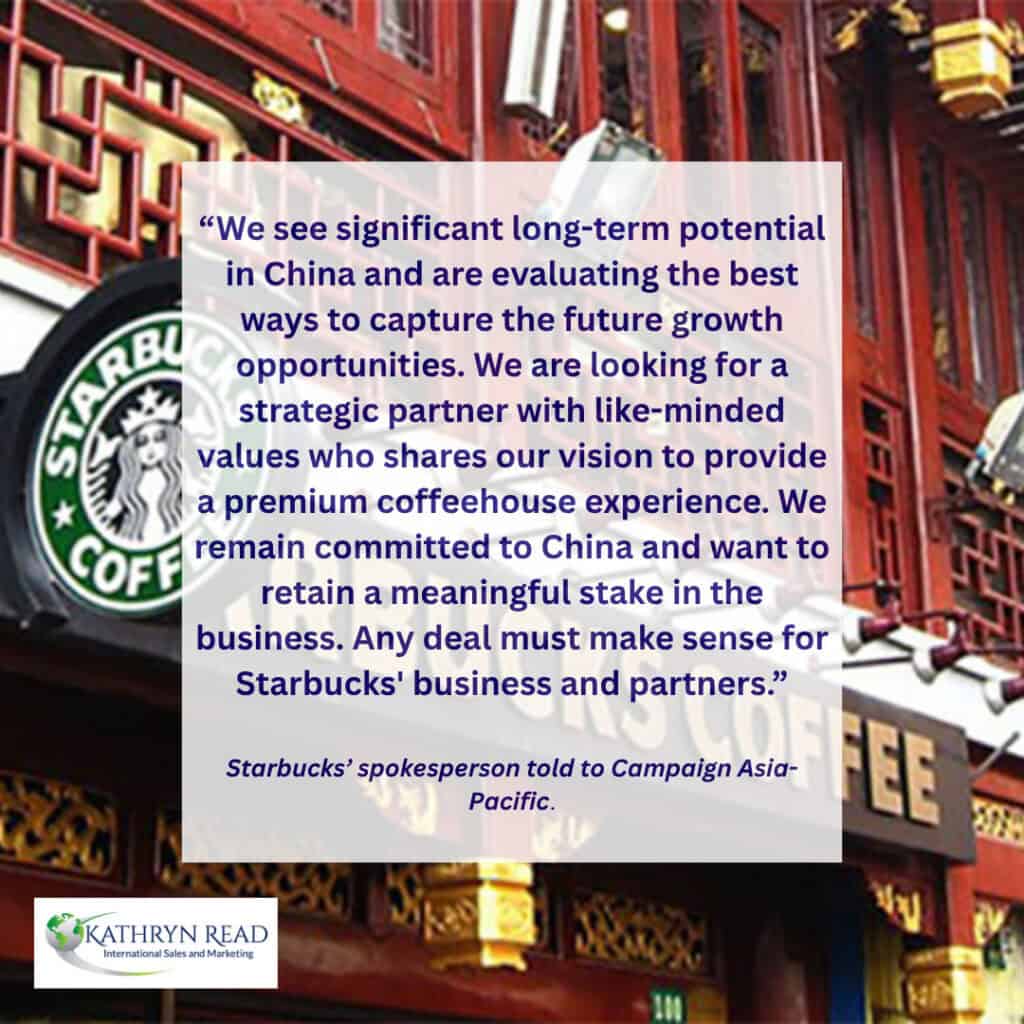By mid‑2025, Starbucks stands at a crossroads – it can’t be denied that Starbucks is struggling in China. Their Q1 FY25 results (to end‑December 2024) revealed a 6% decline in comparable store sales in China, even as it expanded its footprint to 7,685 outlets (up 10% year‑on‑year). While global revenue held flat at $9.4 billion, the China segment delivered just a 1% revenue rise amid weaker same‑store performance, flagging the growing local pressure.
Facing stiff competition from budget‑friendly rivals such as Luckin, Starbucks’ revenue from China reportedly fell from approximately $3.7 billion in 2021 to around $3 billion in 2024, and its Shanghai market share halved to roughly 19% by early 2025. In response, CEO Brian Niccol has launched the “Back to Starbucks” turnaround strategy – simplifying menus, investing in staffing, refreshing marketing, and rolling out price cuts, especially on iced and tea‑based drinks by about RMB 5 (~ $0.70).
In mid‑2025, Starbucks confirmed it is exploring a partial stake sale in its China business after receiving nearly 30 bids, including from Centurium Capital (backer of rival Luckin), Hillhouse Capital, Carlyle and KKR. The business is valued at up to $10 billion, and Starbucks aims to retain roughly a 30% stake, potentially distributing the remainder among several partners to avoid giving one investor undue control
Table of Contents
Early Success for Starbucks in China
Starbucks first entered the Chinese market in 1999 with a clear long-term vision: to introduce not just coffee, but a new kind of lifestyle experience to a historically tea-drinking culture. As I noted in my blog post about the market entry, the brand played the long game, prioritising brand-building and education over short-term profits.
Early on, Starbucks differentiated itself by positioning coffee as a premium, aspirational product. Stores were designed as upscale, comfortable “third places” which were neither home nor office & that encouraged lingering and connection. This resonated particularly well with China’s rising middle class and urban professionals, who saw Starbucks as a symbol of modernity and success.
The company also made strategic localisation efforts early on, including offering green tea lattes, mooncakes during Mid-Autumn Festival, and gradually expanding store formats based on local demand. Its initial success hinged on patience, consistency, and cultural sensitivity — taking time to learn the market rather than forcing a Western format to fit.
By the late 2010s, Starbucks had cemented its place as a market leader, with a reputation for quality, service, and lifestyle appeal. However, as the market has evolved, particularly post-pandemic, that premium positioning has come under pressure from more agile, value-driven local rivals.
The Local Competition Piles in: Why Starbucks Is Struggling in China
Starbucks may have pioneered premium coffee culture in China, but it’s now being seriously challenged by a new wave of nimble, homegrown competitors – most notably Luckin Coffee, along with fast-rising players like Cotti Coffee and Manner. The brand’s current struggles in China can’t be understood in isolation; they’re a direct result of this increasingly competitive and fast-moving landscape.
Price and Perception: The Value Equation
Luckin’s biggest weapon is pricing. While its menu prices may not seem drastically different at first glance, it’s the near-constant discounts and coupons that make the real difference. In practice, a latte at Starbucks can easily cost two to three times as much as the same drink from Luckin. Cotti and Manner also operate in the same value-driven space, typically offering drinks for half the price of a Starbucks.
This aggressive pricing has struck a chord with Chinese consumers, many of whom are still tightening their belts after the pandemic. The country’s younger generations (arguably the most important coffee demographic in China) are increasingly value-conscious, and Starbucks’ historic reluctance to offer discounts has worked against it. While Starbucks pricing strategy in China has started to change (to roll out some promotions and price cuts, particularly on non-coffee items), these steps have largely been criticised as too limited to shift perceptions meaningfully.
Speed and Scale: A Tale of Two Models
Another reason Starbucks is struggling in China is the sheer speed at which its competitors are scaling. As of Q1 2025, Luckin has over 24,000 stores in China – more than triple Starbucks’ 7,685. This has been made possible by its “no-frills” operational model: small-format shops with minimal seating, often squeezed into campuses, hospitals, and transit hubs, and a fully digital ordering experience.
Crucially, Luckin has embraced franchising through its “partnership store” model, enabling it to grow rapidly and cost-effectively across lower-tier cities. Starbucks, by contrast, has historically insisted on 100% company-operated stores, a strategy that ensures brand control but limits speed and flexibility.
Adapting to Evolving Preferences
Luckin also outpaces Starbucks in its ability to respond to consumer trends. Its menu is constantly evolving, with monthly flavour drops and seasonal localisations that feel fresh and relevant. Starbucks has made some strides here, but still tends to move more cautiously and centrally.
It’s worth noting that while Starbucks remains the taste leader in many consumer rankings, Luckin is increasingly seen as the brand that delivers better value and that’s what’s driving market share gains. Chinese consumers no longer just want Western-style coffee; they want affordable indulgence and convenience, combined with a local touch.
The Cultural Undercurrent
There’s also a more subtle challenge that foreign brands ignore at their peril: nationalism. Although most Chinese consumers don’t actively reject Starbucks, there’s a growing preference for homegrown brands, especially in the context of ongoing political tensions between the U.S. and China. “Patriotic coffee” (= proudly Chinese, digitally native, and locally tailored) increasingly resonates with consumers in ways a Western brand might struggle to emulate.
What can other overseas brands learn from Starbucks’ example?
For brands looking to succeed in China’s consumer markets, Starbucks’ experience offers several crucial learnings:
Don’t take early success for granted; the market matures rapidly
Starbucks initially found China to be a “fertile growth opportunity” and a “poster child of successful international expansion”. Their growth was relatively unchallenged until 2017 and Starbucks is credited with having defined the culture of coffee in China, historically a tea-drinking nation. However, the market “matured” quickly with multiple entrants. This highlights that early dominance can quickly erode as local competition emerges and market dynamics shift.
Even if you have a unique product, don’t assume that the Chinese cannot also produce a high quality version of it to rival yours. So keep evolving to try and stay one step ahead of the game.
Be prepared for intense competition and rapid innovation from local players
The entry of Luckin Coffee in 2017 dramatically changed the landscape. Luckin’s “bare bones, pared down coffee shop” model allowed for rapid expansion into diverse locations like universities and hospitals, often with very small footprints. This contrasts with the Starbucks’ more traditional in-store experience.
Local competitors can outpace Western brands in scale and speed!
Adapt your pricing strategy to evolving consumer economic conditions and local competition
Starbucks built its success in China on a premium positioning that worked well when consumer confidence was high. But in the post-pandemic landscape, with growing economic pressures, Chinese consumers have become far more value-conscious. That’s where local players like Luckin have found their edge – consistently undercutting Starbucks on price and pushing aggressive discounts that the Seattle giant has traditionally avoided. Other challengers like Cotti and Manner often sell at half the price of a Starbucks latte.
Starbucks has had to respond with promotions and limited price cuts, but these moves have largely fallen flat and many consumers see them as too little, too late. The broader takeaway? Premium pricing only works if you’re delivering value that justifies it. And in a fast-moving, price-sensitive market like China, brands have to stay agile and be willing to flex their model when the ground shifts under them as the market evolves.
Embrace digital transformation and mobile-first strategies
One of the key reasons Starbucks is struggling in China is its slower start in adapting to the mobile-first habits of Chinese consumers. While Starbucks was still focused on the in-store café experience, Luckin surged ahead by pioneering a fully app-based ordering model that was fast, frictionless, and built for busy, value-driven customers. (If I’m in China, I order my coffee within the mini-APP within Alipay before I arrive and then collect at the shop with minimal wait). At first, Starbucks lagged behind in digital engagement, but it’s been playing catch-up by partnering with local giants like Meituan and Grab for delivery and payment integration.
In a market where convenience and tech integration are non-negotiable, a strong digital strategy is more than just nice to have, it’s absolutely essential. The brands winning in China are the ones that embed themselves into local digital ecosystems, not the ones clinging to global formats that feel clunky or outdated in a Chinese context.
Prioritise deep localisation of products and marketing
If Starbucks is struggling in China, it’s not just about price but also about relevance. Industry experts argue that the brand’s focus shouldn’t be on racing to the bottom in a price war, but on sharpening its localisation strategy. That means adapting menus, marketing and even the brand’s cultural cues to better reflect local tastes. Hint: the recent price reductions on teas are just “marketing fluff”.
Luckin has shown what’s possible by rolling out limited-time flavours every few weeks, tapping into everything from traditional Chinese desserts to viral social media trends. Starbucks has made some moves in this direction, but still lags behind in terms of speed and experimentation. In China, this kind of localisation is a business necessity, not some kind of buzzword.

Don’t sacrifice service for savings
Another reason Starbucks is struggling in China is that cost-cutting has started to nibble away at one of its historic strengths: service quality. Reports of rushed or impersonal service, and even customers being asked to leave or make a purchase under pressure, haven’t done the brand any favours.
In response, the company is investing in revamping the in-store experience with a return to the “third place” concept that made Starbucks aspirational in the first place. The lesson here is simple: if you’re charging premium prices, you need to deliver a premium experience, even when margins are tight.
Rethink ownership models for greater agility
Starbucks’ traditional China strategy has centred around full company ownership. That worked well in the early days, but in today’s fast-evolving environment & with sales under pressure, it’s become clear that this approach limits speed and flexibility, especially outside the major urban centres of tiers 1 & 2.
Luckin’s explosive growth through franchising stands in stark contrast to this. Now, Starbucks is reportedly exploring strategic partnerships, licensing, and joint ventures in a shift toward a more “asset-light” model to reduce operational and earnings volatility. For foreign brands, this kind of flexibility is a way of hedging against political risk and enabling local responsiveness.
Understand the mood: national pride matters
Starbucks isn’t necessarily the target of anti-Western sentiment, but there’s no denying that rising nationalism and political tensions are influencing consumer choices. Many Chinese customers are increasingly drawn to the “patriotic” coffee served by homegrown brands that feel more aligned with local identity and values.
This doesn’t mean Starbucks has to compromise its DNA, but it does suggest that having a strong local partner and a more nuanced approach to brand storytelling could help safeguard reputation and build trust in an emotionally charged climate.
Keep the long game in sight
Yes, Starbucks is struggling in China today, but that doesn’t mean it’s game over. CEO Brian Niccol has publicly reaffirmed the company’s long-term commitment to the market, with plans for thousands more stores. Coffee consumption in China is still in its early stages, and there’s room for further education and expansion – especially outside Tier 1 cities.
Brands hoping to succeed in China must balance short-term tactical pivots with long-term vision. Fluctuations in consumer behaviour, economic cycles, and political climates are all part of the journey. Staying the course, while adapting along the way, is key.
Not Game Over, But Time to Pivot
Starbucks is undeniably struggling in China today with its premium strategy under strain, local rivals biting into market share, and younger consumers sharpening their value expectations. Yet the outlook isn’t totally bleak. The company’s newly released Q3 FY2025 results offer reason for cautious optimism. While global same‑store sales fell for the sixth consecutive quarter, comparable-store sales in China rose 2%, signalling a reversal in the decline trend.
Crucially, the “Back to Starbucks” reset led by CEO Brian Niccol is gaining traction. Early signs of recovery include a simplified menu, stronger staffing, refreshed store ambience, and stronger customer engagement features like handwritten cup messages. Investors responded positively & the stock jumped 3–5% following the earnings report.
However, this is still a turnaround story, not a triumphant revival. Starbucks continues to face intense competition, high operational costs, and the lingering effects of over‑expansion. Niccol has emphasised that pricing remains a last resort, suggesting the real focus should be on service and brand restoration .
So, what does this mean for Starbucks’ future in China?
- Leadership agility matters: Niccol’s willingness to re-examine old assumptions, invest in service, and modernise store formats is a solid pivot.
- Structural evolution is underway: Exploring joint ventures and licensing could help scale faster, reduce volatility, and bring in the local know-how needed in China.
- Local partnership offers resilience: A hybrid ownership strategy combining strategic partners with company ownership allows brand control while adapting to regional nuances.
In short, yes, Starbucks is navigating a challenging period in China. But with management willing to embrace structural changes, remain agile in pricing and product localisation, and recommit to delivering service excellence, the company still has room to manoeuvre. While the glory days of dominance may not return, there remains a path forward – not through retreat, but through thoughtful reinvention.
Thinking that working with a consultant would accelerate your international expansion?
If you’d like to learn more about working with me for support on your internationalisation projects or personal export knowledge, you can book a 30 minute international clarity call here.
If you haven’t already signed up for my free e-book about how to select which international market to enter next, you can do so here, or using the form below.
If you enjoyed this content please share it on social media or recommend it to your network.
Pin this post for later!
If you are interested in selling in China, you might also find these posts interesting:
- Successful Selling in China Part 1: The Background
- Successful Selling in China Part 2: Do the Due Diligence
- Successful Selling in China Part 3: Building Guanxi for Success
- China Challenges Part 1: Underestimating China
- China Challenges Part 2: Understanding Chinese Business Culture
- China Challenges Part 3: Keeping up with “China Speed”
- China Challenges Part 4: Finding the Right Partner
- China Registration Regulations for Overseas Food Manufacturers from 2022
- New Trends in China, new Opportunities in Trade
- Top Basic Concepts of Cross Border E-Commerce in China
- Alberto Antinucci: Preparing the Best Market Entry Strategy
- Julia Bingel: Top Tips for Entering the Market
- Laura Cortes: Custom Product Development and Sourcing
- Food and Beverages Trends You Should be Evolving with
- A Sweet Business Opportunity? Entering the Chocolate market
- Get the Scoop on the Ice Cream Market in China
Marketing in China:
- What is Zhihu? How can you use this for your B2B Marketing in China?
- Have you thought about using Kuaishou for China Marketing?
- Using Bilibili marketing in your China Strategy
- Livestreaming driven social commerce in China as the future growth engine?
- Leverage Toutiao’s AI to target Chinese consumers for your brand
- What are the Differences between Douyin & TikTok?
- How Double 11 online shopping festival evolved in 2022
- Trends to Focus on in Chinese Consumer Behaviour
- China’s Pet Market Trends & Consumer Behaviour
- Strategies for Successful CNY ads
- Chinese Marketing Calendar for the Year of the Dragon
- Analysing the Phenomenal Success of Jellycat in the Chinese Market
Other relevant posts:
- The 2022 Beijing Winter Olympics: Sustainable & Digital
- A Short Guide to Navigating the New China Data Privacy Laws
- Lunar New Year Traditions around Asia
- What is the story of the Chinese Zodiac Animals?
- Year of the Tiger 2022: what can you expect working with Tigers?
- 2023 Year of the Rabbit Characteristics: what is your benmingnian year?







